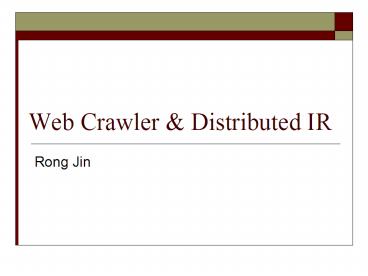Web Crawler PowerPoint PPT Presentation
1 / 23
Title: Web Crawler
1
Web Crawler Distributed IR
- Rong Jin
2
A Basic Crawler
- Initialize queue with URLs of known seed pages
- Repeat
- Take URL from queue
- Fetch and parse page
- Extract URLs from page
- Add URLs to queue
- Fundamental assumption
- The web is well linked.
3
Challenges
- Fetch 1,000,000,000 pages in one month
- almost 400 pages per second!
- Latency/bandwidth
- Politeness dont hit a server too often
- Duplicates
- Spider traps
- Malicious server that generates an infinite
sequence of linked pages - Sophisticated spider traps generate pages that
are not easily identified as dynamic.
4
What A Crawler Should Do?
- Be polite
- Dont hit a each site too often
- Only crawl pages you are allowed to crawl
robots.txt - Be robust
- Be immune to spider traps, duplicates, very large
pages, very large websites, dynamic pages etc
5
Robot.txt
- Protocol for giving crawlers (robots) limited
access to a website, originally from 1994 - Examples
- User-agent
- Disallow /yoursite/temp/
- User-agent searchengine
- Disallow
- Important cache the robots.txt file of each site
we are crawling
6
What A Crawler Should Do?
- Be capable of distributed operation
- Be scalable need to be able to increase crawl
rate by adding more machines - Fetch pages of higher quality or dynamic pages
first - Continuous operation get fresh version of
already crawled pages
7
Basic Crawler Architecture
8
Basci Processing Steps
- Pick a URL from the frontier
- Fetch the document at the URL
- Check if the document has content already seen
(if yes skip following steps) - Index document
- Parse the document and extract URLs to other
docs - For each extracted URL
- Does it fail certain tests (e.g., spam)? Yes
skip - Already in the frontier? Yes skip
9
URL Normalization
- Some URLs extracted from a document are relative
URLs. - E.g., at http//mit.edu, we may have
/aboutsite.html - This is the same as http//mit.edu/aboutsite.html
- During parsing, we must normalize (expand) all
relative URLs.
10
Content Seen
- For each page fetched check if the content is
already in the index - Check this using document fingerprints or
shingles - Skip documents whose content has already been
indexed
11
Distributing Crawler
- Run multiple crawl threads, potentially at
different nodes - Partition hosts being crawled into nodes
12
URL Frontier
- Must avoid trying to fetch them all at the same
time - Must keep all crawling threads busy
13
URL Frontier
- Politeness Dont hit a web server too
frequently - E.g., insert a time gap between successive
requests to the same server - Freshness Crawl some pages (e.g., news sites)
more often than others - Not an easy problem
14
URL Frontier
- Front queue manage priority
- Each front queue corresponds to a level of
priority - Back queue enforce politeness
- URLs in each back queue share the same web sever
15
Multi-Thread Crawlers
- Extract the root of the back queue heap
- Fetch URL at head of corresponding back queue q
- Check if q is now empty
- If yes,
- pulling URLs from the front queues, and
- adding them to their corresponding back queues
until the URLs host does not have a back queue
then put the URL in q and create heap entry for
it.
16
Federated Search
- Visible Web
- Accessible (crawled by) conventional search
engines like Google or Yahoo! - Hidden Web
- Hidden from conventional engines (can not be
crawled). - Accessible via source-specific search engine
- Larger than Visible Web (2-50 times, Sherman
2001) - Created by professionals
17
Example of Hidden Web
18
Example of Hidden Web
19
Example of Hidden Web
20
Distributed Information Retrieval
. . . .
. . .
. . .
(1) Resource Representation
(2) Resource Selection
(3) Results Merging
- Source recommendation recommend sources for
given queries - Federated search search selected sources and
merge individual ranked lists into a single list
21
Resource Description
- Description by word occurrences
- Cooperative protocols
- Eg. STARTS protocol (Gravano et al., 1997)
- Query sampling based approaches
- Collect word occurrences by sending random
queries and analyzing the returned docs - Build centralized database by the returned docs
of random queries - Good for uncooperative environment
22
Resource Selection
- Select information sources that are most likely
to provide relevant docs for given queries - Basic steps
- Build a word histogram profile for each database
- Treat each database as a big doc, and select
the database with the highest relevance for given
queries
23
Result Merging
- Merge the returned docs from different databases
into a single list - Challenges
- Each database only returns a list, no scores
- Each database may use different retrieval
algorithms, making their scores incomparable - Solution
- Round and robin
- CORI merging algorithm (Callan, 1997)
- Calibrate the scores from different database

